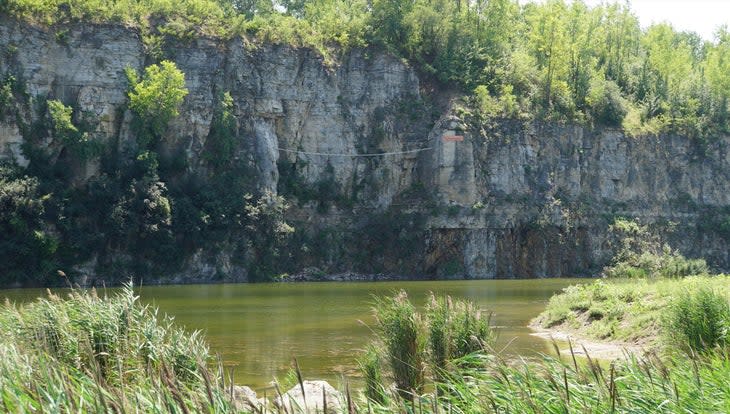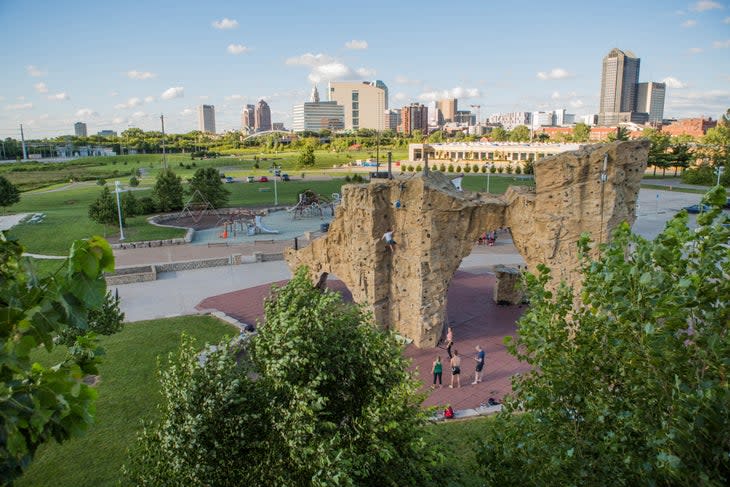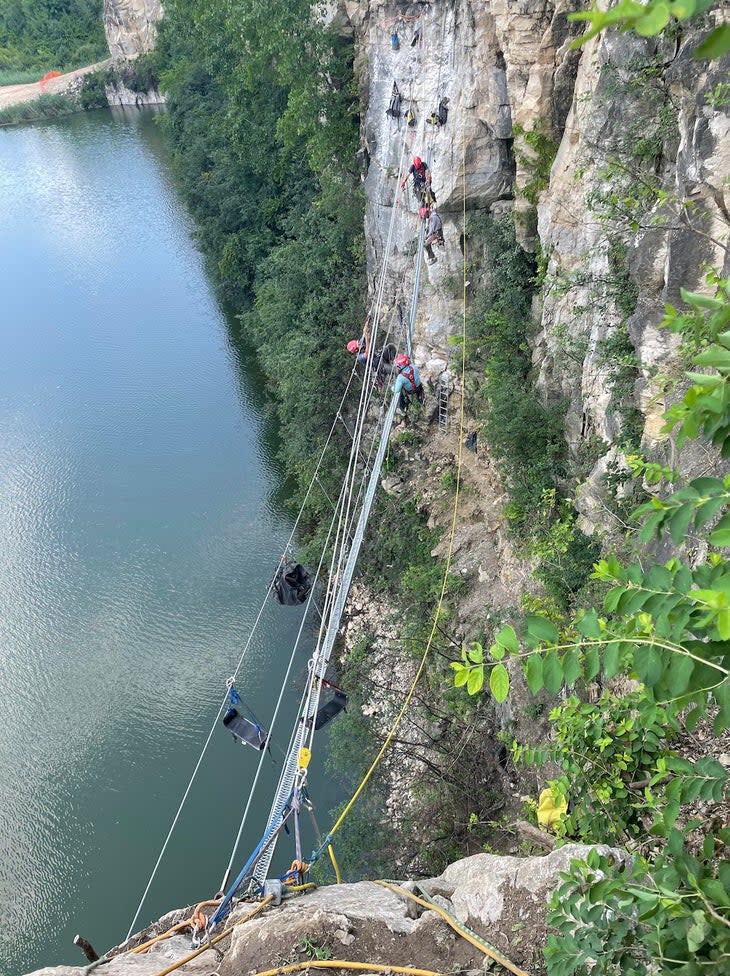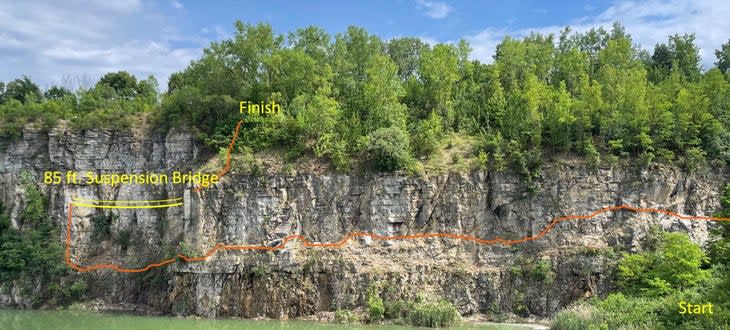Ohio Is Getting the Country’s First Urban Via Ferrata
This article originally appeared on Outside
Five miles northwest of downtown Columbus, Ohio, a once unremarkable limestone cliff is about to make an innovative mark on the world of outdoor recreation.
The wall, part of a defunct quarry, sits at the center of a new 180-acre park that has been transformed over the past few years into a recreational refuge: Quarry Trails Metro Park, which is just the latest addition to the state's large (though little publicized) collection of outdoor-adventure opportunities. As for that limestone cliff, it's set to become the site of an 800-foot horizontal traverse designed for a mountaineering style of climbing called a via ferrata--the very first such urban route in the country.
"Columbus has this awesome energy and foresight that other communities should look to for inspiration," said Reed Rowley, cofounder of the Colorado-based Via Ferrata Works, whose company was hired to build the route, which opens later this fall. "This is a model that needs to be replicated in other places."
As more midwestern communities like Columbus reposition themselves for young consumers eager to get outside, projects like the Quarry Trails Metro Park are helping tear down the stereotype of heartland states as flyover country unsuited to good hiking, biking, paddling, and climbing. Ohio's new park, and particularly its via ferrata, proves it's possible for states without mountain ranges to provide access to experiences once found only in the Rockies or the Sierra. It's a win for all involved--states, businesses, and consumers alike.

Ohio's Current Outdoor Offerings
From the forests and ravines of Cuyahoga Valley National Park to the southern shores of Lake Erie, Ohio's outdoor recreation opportunities are already wide and well established. According to the Bureau of Economic Analysis, Ohio's outdoor sector generated $10.6 billion and more than 131,000 jobs in 2020. Boating, fishing, RVing, ATVing, and hunting are among the most popular activities.
Columbus, the state's capital, with a population approaching 900,000 and growing fast, is leading the state in its investment in outdoor access. Even before the climbing boom of the past several years, the city in 2009 opened the Scioto Audubon Metro Park with the country's largest climbing wall that’s free to the public. "Our goal with that park was to keep urban young professionals in Columbus," said Dan Kaderly, park operations manager at Metro Parks, a tax-funded public agency tasked with constructing public green spaces in central Ohio. "When we do things like this, they become destination areas."

The vision for Quarry Trails--and the state's bet on consumer demand--is grounded in some of the most compelling evidence a city planner could hope for: prior use.
Just two years ago, the park property was part of the out-of-service Marble Cliff Quarry, one of the oldest contiguous quarries in Ohio, established in 1840. Left abandoned, it had turned into a deep dirt pit of debris and boulders. A handful of in-the-know locals ventured there for recreation--but it was unauthorized, spread by word of mouth only. "You had to belong to the underground outdoor community to even know about it," said Lisa Daris, owner of Olentangy Paddle, a kayak-touring company nearby. "This will just add another degree of excitement and opportunity to explore the natural wonders of Ohio."
Now there's an established road and adjacent greenway path to the quarry. With the Scioto River nearby, plus two quarry lakes connected by a channel, paddlers can spend the day exploring the waterways. Mountain bikers have access to loops of singletrack and a newly installed pump track. Hikers come for the native plants, wildlife, and winding paths and observation decks overlooking the 25-foot-tall Milliken Falls.
In the middle of that outdoor haven, the quarry's 1,200-foot-long and 150-foot-high limestone wall was an obvious candidate for a via ferrata; but it took a visionary design-build company to make it happen. That’s where Via Ferrata Works came in.
Via Ferratas in Ohio: Risky Gamble or Natural Fit?
Via Ferratas are most well-known in Europe, where they were invented, but other countries are catching up. The U.S. is becoming a hot spot, with established offerings in Taos, New Mexico; Jackson, Wyoming; Mammoth Mountain and Olympic Valley, California; and several cities in Colorado. But anyone associating them solely with the West might be surprised to learn that the country's first one was actually in Kentucky--and the second in West Virginia.
Historically, said Bryan Williams, manager of the West Virginia course, Nelson Rocks, "the vast majority of our guests have never heard the phrase via ferrata until they find us." But, he said, that's starting to change. The pandemic-fueled expansion of climbing participation across the country has widened his course's clientele noticeably in the past few years.
In Columbus, the term isn't so unfamiliar. An indoor adventure park called Play: CBUS opened in 2020 with two via ferratas. The owner, Greg Carlin, said his via ferrata is intended for entry-level climbers--a gateway for outdoor exploration. "We take pride in helping expose people to climbing and hope they seek out more opportunities for it, indoors and outdoors," he said. "I see the outdoor via ferrata in much the same way. I can't wait to see it and try it myself and hope it gets people seeking out other adventure businesses."

Jed Johnson, a board member at Ohio Climbers Coalition, said he sees Ohio--and particularly Columbus--as poised for a major boom in climbing interest. To him, the sell to locals will be easy, even if they've never heard of via ferratas before, as most of them are eager for more outdoor rec. "There's a ton of perks to living here," he said. "When you start to see [your] city investing in these types of resources, it's a great opportunity for all of us."
Johnson is already getting calls from non-climbers interested in the new via ferrata, which he sees as evidence of opportunity for area retailers, guiding services, and tour companies. Experience Columbus, the city's tourism board, plans to capitalize on the new feature by adding "urban via ferrata" to the section on its website for outdoor activities once the new park opens.
Along with Play: CBUS, local businesses that stand to benefit from a more robust outdoor scene include Zip Zone, an outdoor zip line and treetop obstacle course; several area climbing gyms, like Bloc Garten, Chambers Purely Boulders, and Vertical Adventures; and nearby retailers like Bikesource Columbus, Dick's Sporting Goods, Mad River Outfitters, a North Face storefront, Public Lands, two REI locations, and the Simon Kenton Scout Shop.
Spreading Something New
As for marketing the new via ferrata to folks unfamiliar with this form of recreation, Metro Parks has plans for deliberate messaging. Via ferratas can be dangerous without the proper awareness and precautions, even though virtually all courses are designed safely, often with metal rungs for climbers to hold onto as they traverse and special double-carabiner systems that make it impossible to detach from suspension lines on the wall. Even so, to promote safety, Metro Parks' outdoor adventure team will partner with local organizations and businesses to spread education and awareness of responsible climbing practices. The payoff will be a well-informed group of consumers poised to help the city grow.
"This new experience will be something that draws outdoor enthusiasts from around the region and country to Columbus," said Leah Berger, public relations manager at Experience Columbus.
The Ohio Climbers Coalition is also helping with the educational campaign. Johnson and a few other members of the Coalition were recruited by Metro Parks to help scout potential climbing routes when the city was breaking ground on the park. Despite the abundance of rock, though, the group came to the conclusion that the limestone was too fractured to establish safe bouldering, top-roping, or sport-climbing lines.
The hesitation makes sense. Recreating in quarries isn't a new concept, but it's not a popular option. Working with rock once blasted by explosives comes with unique challenges. "We really tried, and there just wasn't anything we felt comfortable with," Johnson said. But the via ferrata, he added, is an exciting prospect that makes good use of the wall and is accessible to both experienced climbers and newcomers alike.

Rowley, at Via Ferrata Works, sees the new project as a win-win for communities. For municipalities, it transforms hazardous areas into useful public properties. For climbers who don't live near the mountains, it provides a nearby open-air climbing experience.
"Walking across an 85-foot suspension bridge while you're on belay kind of sells itself," said Rowley. "It's a build-it-and-they-will-come kind of attraction."
Via Ferrata Works is already getting inquiries from other communities in the Midwest and on the East Coast interested in putting up similar routes, and the company has begun work on designs in other states. Rowley wasn't willing to divulge any of those potential locations--yet--but he did have one teaser to share: look forward to more via ferratas in unlikely places.
For exclusive access to all of our fitness, gear, adventure, and travel stories, plus discounts on trips, events, and gear, sign up for Outside+ today.

